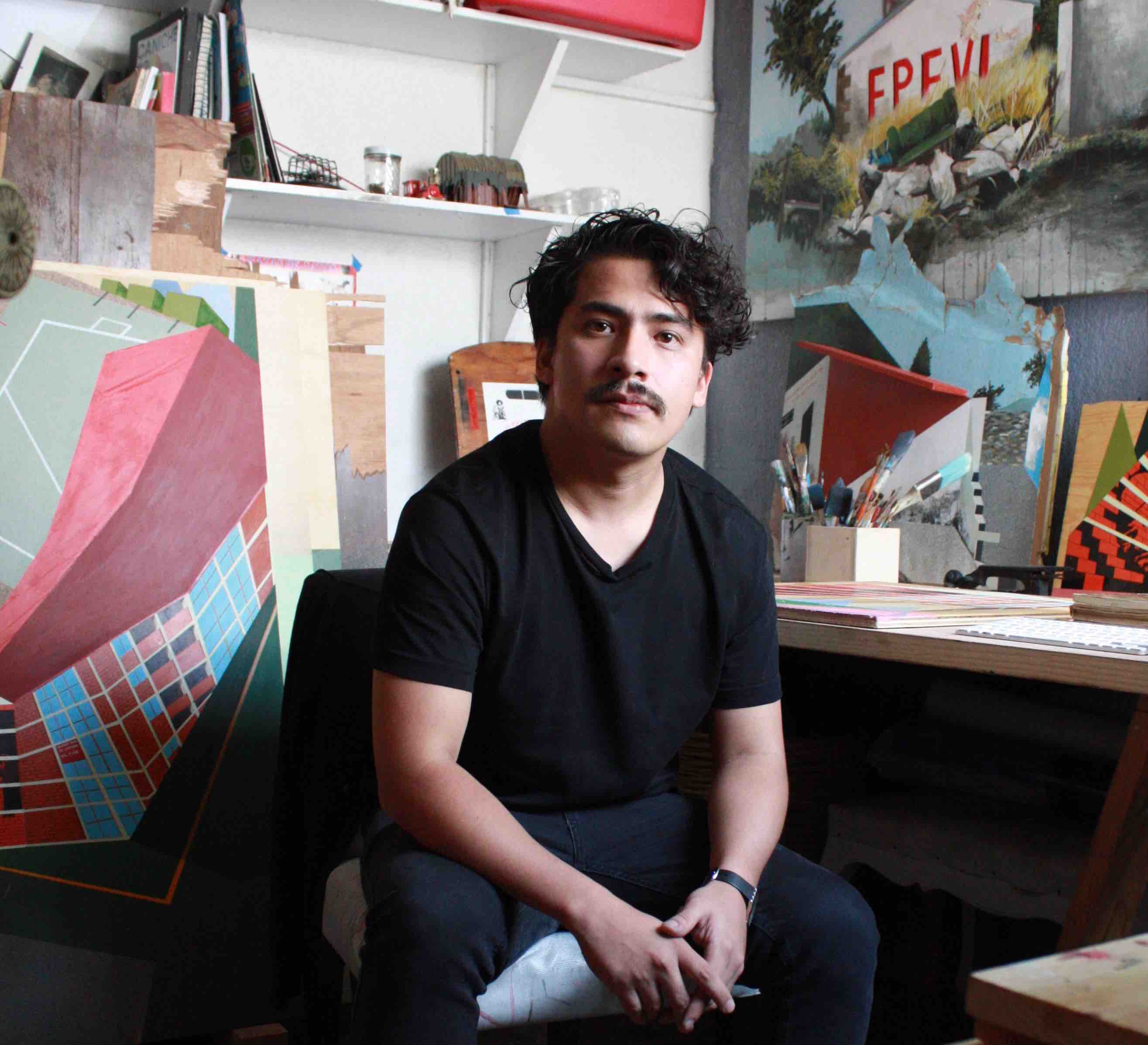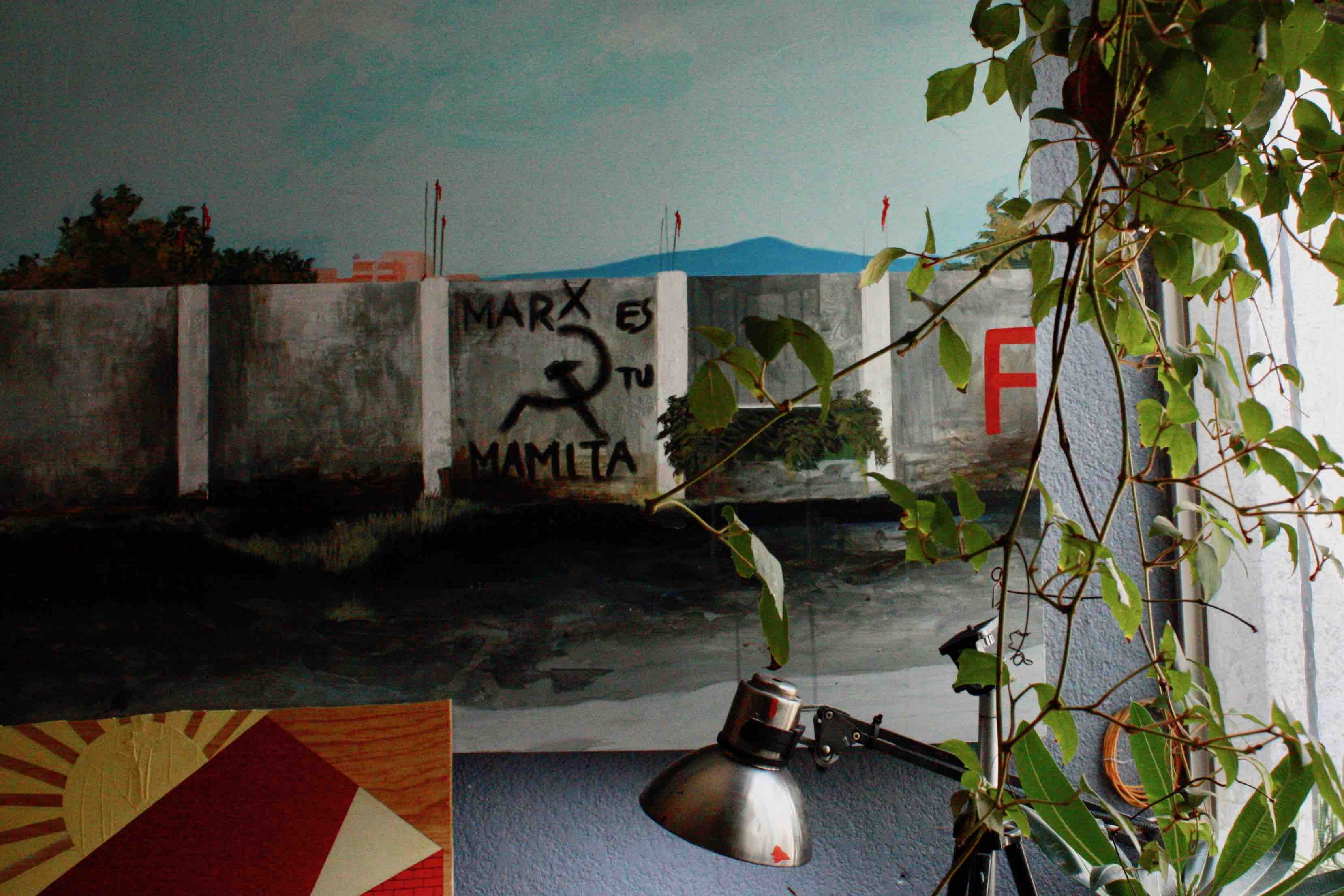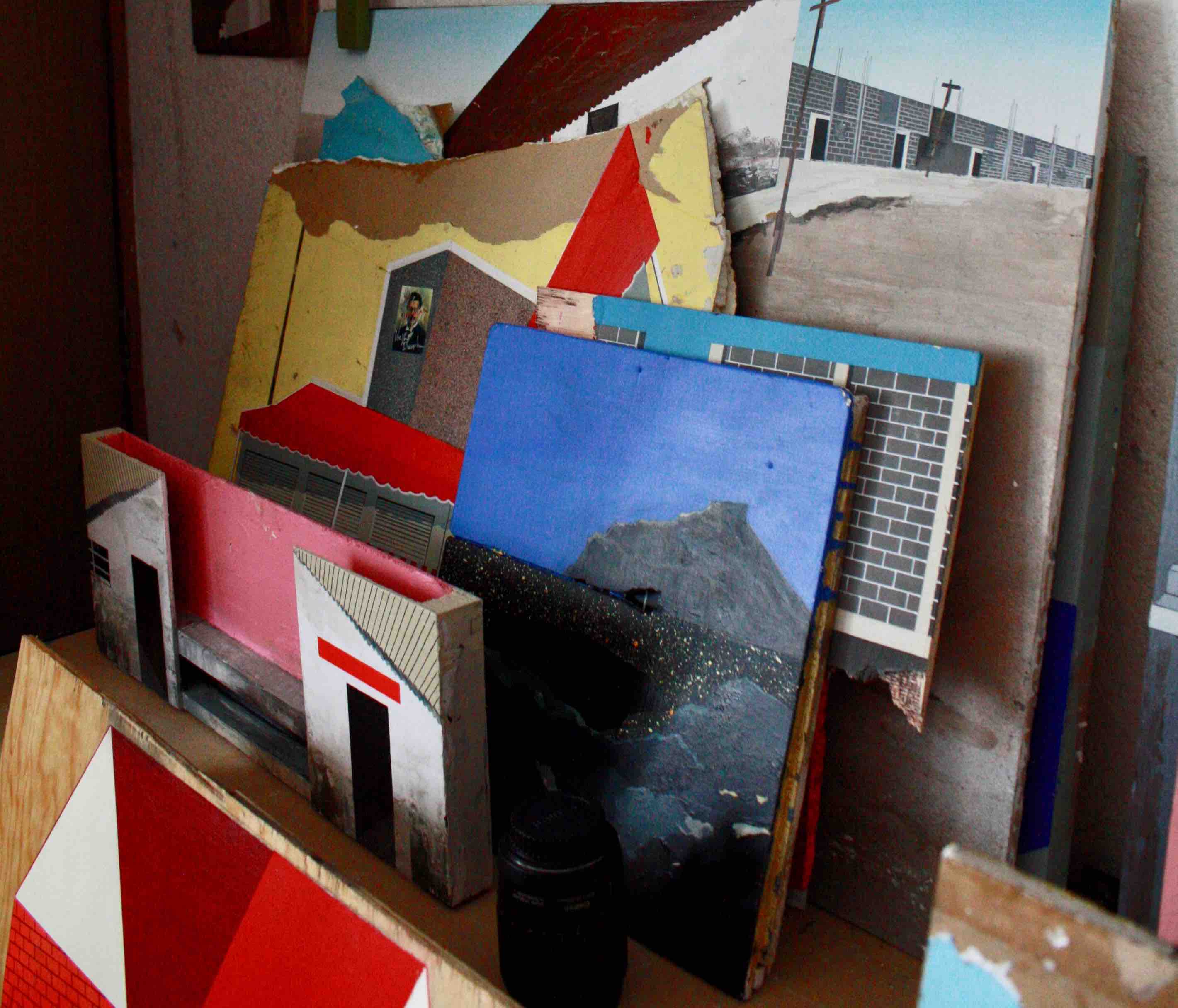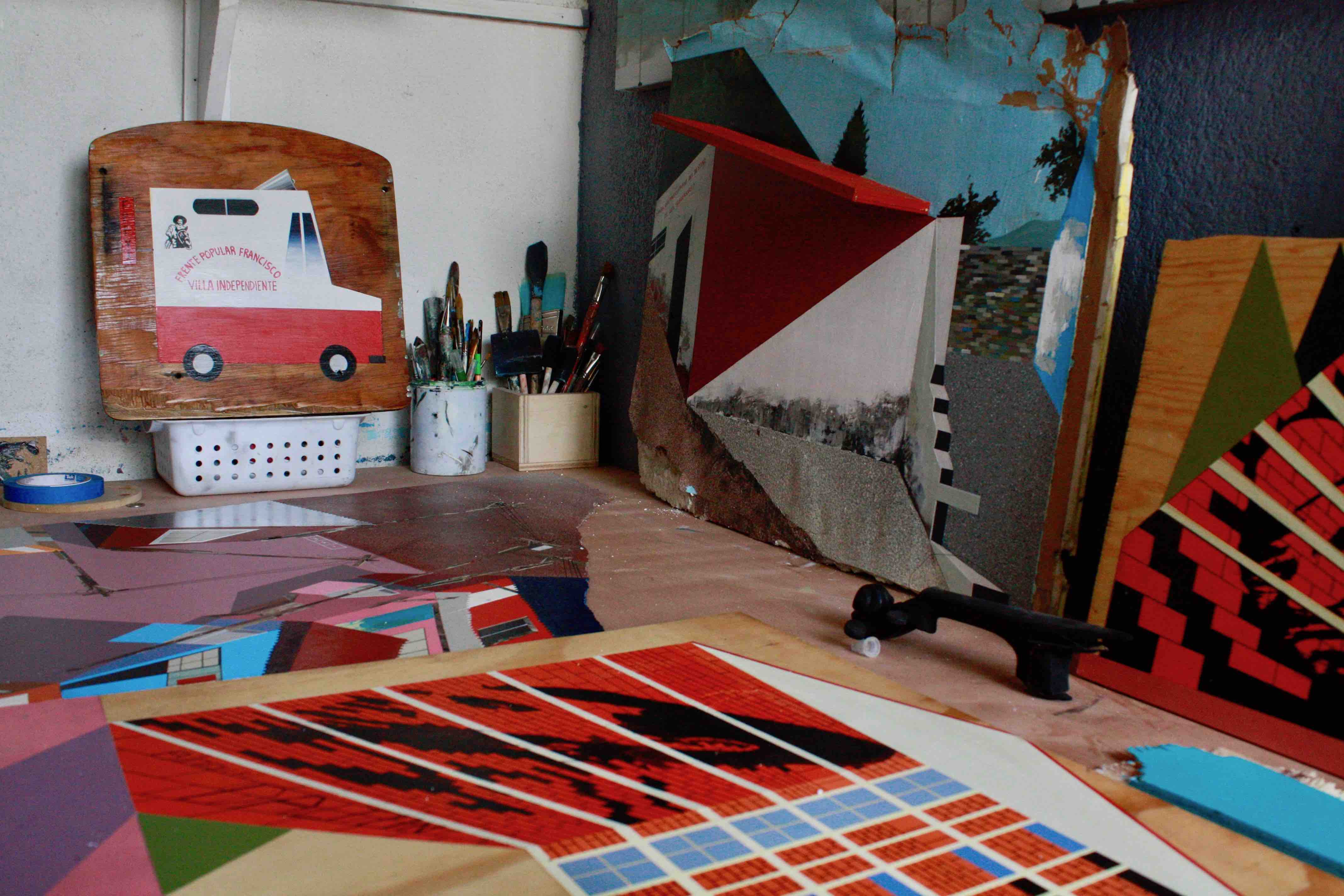
Interview
Néstor Jiménez's studio visit
by Bruno Enciso
"I also feel that the work of painting brings me closer to the people, since in the end painting is a craft and everyone who works in the front also has a craft."
Reading time
20 min
I visited Néstor Jiménez in his Mexico City studio, located in Colonia Casa Blanca, Iztapalapa. We spoke about his relationships to his studio and to his neighborhood, and about the movement of popular fronts, with which he has worked for some time. Néstor is preparing a new body of work in which he explores popular fronts—and their complexities—in order to take on such themes as social self-organization, socialism in Mexico, as well as the emerging housing crisis. Nueva Aztlán y Quebrantahuesos will be presented in the gallery Proyectos Monclova as part of Gallery Weekend 2019.
Bruno Enciso (BE): Hi Néstor. Thanks for having me. It’s always a pleasure to be in an artist’s studio since it’s something so personal.
Néstor Jiménez (NJ): Thanks! I also like having people in the studio. I think it’s good for exchanging impressions about the work, and also for getting away from the idea of the studio as something cryptic.
BE: So then let’s talk about the studio. Since the moment I learned that it was here in Iztapalapa I smelt a connection with your work. Tell me how you arrived here.
NJ: I arrived here around 2012-2013. The building has for me a personal history that I should talk about because it touches on themes that I explore in my work. Around that time my father was unemployed, and it was very difficult for him to find work appropriate for his level of education and for his age. He got the apartment through an INFONAVIT credit, which is a housing credit for workers. When he lost his job a period of economic crisis came home to us—I would have been 22 at the time—and he said to me: “You know what son, I can’t pay for the apartment but at the same time I’ve been paying for it for twenty years, and I don’t want to lose it,” which was a real possibility because the policies of INFONAVIT were so strict. There are a lot of programs that disguise themselves as social assistance, but they’re really just debts that you’ll have hanging onto you for the rest of your life. My father proposed that I help him with the payments. I accepted because it seemed like something I should do for my family and also because I got to see what it was like to have my own place.
When I was a kid, this apartment was only for the weekends. It was really cheerful, those weekends in Iztapalapa. So we never took into account what life was like here or in the area surrounding it. We got it in 1999 when all the real estate options were just beginning, and buying a house on the outskirts was still an option for those who wanted to escape the costs of living in the city center. With this generation of workers you couldn’t so easily sell them those images of standardized capitalism, the ones that tell you, “Don’t worry, just travel!” The priority was buying a house. The idea of family was also still very traditional: you would look for a place to live so you could have a family with a dad, a mom, kids, a dog, and a car.
So in arriving I got a reality check. When I was younger I lived by Miguel Ángel de Quevedo, and there was a big difference in environment and in transportation. They had only just started constructing the number 12 metro line, you could only arrive by taxi—which you couldn’t afford anyway—or by routes that were then taken up by two hours in traffic (which is how you do things on the border between Tláhuac, Iztapalapa, and Xochimilco). At the same time that was good because an area prone to growth involves less violence than in the east-east of the city, where everything is more complicated.
BE: It’s interesting to think of the border as a separate area. Since it seems that as soon as you hear “Iztapalapa” it’s already a place where you don’t want to be.
NJ: Yes. I’m frequently involved in discussions about what it is to romanticize the outskirts. In art it’s very easy to play the sociologist who ends up romanticizing certain ways of life. I think these are dynamics that need to be respected and analyzed but always with care. I learned to live here. Having the studio here became a source of reflection and of work that made me appreciate that I wasn’t born here, and that—although I could speak about my own experience in Iztapalapa—I’m far from understanding it or from thinking like the people who grew up here. I couldn’t claim to be 100% a citizen of the area because of the conditions of my birth and because of my education.
BE: So when you arrived it wasn’t clear that you were going to take on these themes as an artist?
NJ: No. I had studied in La Esmeralda, and I carried an idea of art that I don’t want to call “conceptual”—since that’s not the word—but that was very concentrated on thinking about what art does to art and on which themes art should be concerned with. It didn’t take into account the surroundings, something that always seemed to me circumstantial. At that time I was making video art; only now do I see its connection with my current work, not so much for the medium or the production but rather because it was a series of small films that tried to criticize certain state constructs that appear in domestic education. With my parents I recreated situations in which they would punish me, and this demonstrated how—whether you sympathized with the right or the left—socioeconomic models are reproduced in the home. So even though I thought I was not attending to my surroundings by working with video, thanks to everyday life I was after all thinking about issues related to a recalcitrant reality, almost like a telenovela.
BE: About these themes from your immediate reality, are you informed by the news, from talking with people? How do you work with these ideas?
NJ: I learn lots of things from seeing. Unlike with some other places, in Izatapalapa there isn’t much of a culture of “I’ll go and ask” since you don’t know who you can run into. I think that here one really develops one’s sense of listening. The people talk, and listening to them helps you to understand certain things. Back here for example there’s a park and one doesn’t know why it’s always empty until you listen and you hear a drug deal happening. Similarly, you don’t know why there’s a Pancho Villa flag in certain units or why many people enter a certain house, things like that.
BE: That’s super interesting. You’re talking about a city that can’t be seen.
NJ: I think it has to do with the body because you learn to move in a certain way. Like right now: it’s ten in the morning and there’s no problem with moving about in the street, but at 9 or 10 everything changes. And you see it in people who have no choice but to move in this area and in others that are much more complicated. You accommodate yourself to moving about space in a conscious way.
BE: How have you integrated your experience into your work? What is the scope you’ve set for this project you’re preparing?
NJ: I’ll tell you. It all started in 2013, when an artist friend, Pamela Zeferino, invited me to assemble something with her in an abandoned building near the Guelatao metro station. When we went to see the space we were met by someone who gave us a visitor’s badge. We thought, “What is this?” We were then met by a man who turned out to be the leader of the Independent Popular Front, something I wasn’t familiar with then. He told us that it actually wasn’t abandoned, that it was in fact an encampment of people who had started occupying it around 1993. It was like a CCH (College of Science and Humanities), and it worked for them to live in the classrooms and to have their own settlement.
He explained to us that the settlement ran according to Soviet principles of organization, a very orthodox Marxism-Leninism. I later did research into this model, and into how it had to do with the book The Pedagogical Poem by Makarenko, who was a Russian pedagogue who proposed founding a settlement that would gather and organize kids who were in difficult situations or who were caught up in small-time crime. Makarenko’s idea was to reform the kids through communal work. The model of the encampments here is a bit like that: not only to confront the housing crisis, but also to offer a plan for education. Right now we are seeing a resurgence of these fronts, above all because of the housing problem. They have open calls for people who have nowhere to live, and the agreement is to enter into a dynamic of communal work.
I started working there in order to put on the exhibition, and I left taking account of those fantasies of the city that I had maintained during my artistic formation but that aren’t real, that aren’t really there. And nothing came out of that work process because I couldn’t work with the people. Sometimes there are communities that—because of the nature of their activities, or because they have already worked with artists for several generations—are open to artistic collaborations, but here that wasn’t the case. Little by little, I came to understand that all the connections here are rooted in the work of the community.
The exhibition took place in 2014, and afterward my connection to the front laid dormant for while. Then in 2017 I was sought out by the leader’s daughter, with whom I had always gotten along well. Curiously, she had gone to work for the government and she asked me if I knew someone who could do video-editing. I didn’t have work at the time, so I told her I could do it. That’s how I returned to the theme of the fronts, since I was working with information related to the split in the PRD (Party of the Democratic Revolution) and the founding of the Morena party, something that directly affected the fronts because several had been affiliated with the PRD back when it still represented leftist thought. From there I got to know about the current state of the fronts. Between that and my friendship with the leader’s daughter I established a personal relationship with the people of the Independent Popular Front and I stayed on to work with them.

BE: Do they know your work?
NE: Yes. In fact for an exhibition I had in Nixon a few years ago I collaborated with them on drawings, using the childhood memories of several people who had been in the front since they were children. From that collaboration I came to know the people who are central to what I’m preparing for Proyectos Monclova.
The fronts have several sites because the Independent Popular Front is a division of a major front, the Francisco Villa Popular Front. They consist of many fronts and many divisions, including outside the city. So, these people that I know have an encampment called Nueva Aztlán. And this is super interesting, because it’s directly connected to the myth of a territory’s foundation: the promise of reaching an area where there’s nothing, and to settle there. It’s also one of the most successful projects in the front because it’s a residential unit with very large three-room apartments. They also have help from an architect who grew up in the front. They have always sought for the young people of the front to be trained as lawyers, doctors, or architects, so that they can serve popular causes. It’s all very interesting because they understand architecture a little in reverse. On their view, you don’t do designs, looking to who will live in it; you’re instead conscious of the movement and you attend to its needs.

BE: That also makes me curious about the title. “Nueva Aztlán” makes me think of a certain real-estate or urban-planning lingo, like that Mexico City is the “new Berlin,” or that Anáhuac is the “new Polanco.” It’s designed, like you say, as if it were a kind of accident and not a movement of people.
NJ: Yes. In the fronts it’s common to see on black-brick buildings the likenesses of Soviet thinkers, like Lenin or Marx. Curiously, there also appear two figures that seem out of place, but that are also important for the fronts: Moctezuma and Nezahualcóyotl. For them it doesn’t have much to do with the appearance of the buildings, or even with a political contest between right and left; rather, they are only thinking in terms of opposition. So they don’t do designs, because it’s really a very eclectic movement in its symbols and needs.
BE: And I think there’s a break in the idea that the politics of self-organization must inherit the baggage of the orthodox Soviet left.
NJ: Yes, what happened is that the front arose in 1989 due to the total ineptitude of the government in the 1985 earthquake. In that sense the earthquake of 2017 went over well with them because it once again saw the strengthening of self-organization in the face of bureaucracy. I don’t want to discount the suffering or loss of those affected in the other areas, but here the issue was that the people who lost their houses then couldn’t prove that those houses had existed, even if they had been making payments for forty years. So it doesn’t matter what your politics are. That’s the thing, Iztapalapa can’t be understood with the fronts, but also can’t be understood without the fronts. The fronts mobilize people and money far beyond what the state can offer.
The Soviet legacy you mention is curious because while many of the leaders very much had their formations on the left, the founding of the front (in 1989) coincides with the fall of the Berlin Wall. So while the idea of a world socialism comes to an end, the fronts get installed in Izatapalapa. They were left to stick ideologically to the Cuban revolution and to adopt many of its principles. They adapt.
BE: And you’re working with them for this series.
NJ: Yes. I became friends with the daughter of a leader, that’s very important; and Nueva Aztlán is led by a woman. Obviously there aren’t many female leaders because—as good socialists—there is a lot machismo, but there are already a lot of people wanting to change that (while not neglecting the principles of the fronts). So when I had the BANCOMER fellowship I worked with this woman, Jocelyn, on a text in which I spoke about my experience in the fronts. In that process I became familiar with the construction materials used in Nueva Aztlán, which are the same ones that I use as support for these paintings.
Drywall is something they use a lot for the famous houses of cardboard because they can be built immediately. These are the same pieces of board that I use: sometimes I pick them up and other times I exchange them for new boards with people who already have old, used ones. When they demolish the provisional houses in order to start building new ones, they’re always seeking to recover what’s still useful, what I’m not going to keep myself.
I decided to make them as paintings because it can get really rough and heavy when it comes to something clandestine like the fronts. It’s not that it’s illegal, but the government clearly doesn’t like people going against their policies on informal commerce, on popular housing, and all these things. A photograph could be very problematic. I think there’s something very beautiful about painting as it has to do with the clandestine: in a painting you’ll never know what’s real and what’s not real. Even if I gave evidence of something very specific in a painting, at the legal level it couldn’t be evidence of anything. I also feel that the work of painting brings me closer to the people, since in the end painting is a craft and everyone who works in the front also has a craft.
BE: In listening to you I think of two things that have caught my attention in your paintings. The first is your use of the color silver. Not only does it stand out visually, but its use is not common in painting with realist aims, or in political iconography.
NJ: As I work with found or recovered materials, from the beginning I use a color palette that isn’t completely by my own choice. In this one, for example, the drywall was already yellow because it came from the yellow room of some residence. So I do decide on the colors but I’m working with that as a starting point.
The rest of the colors have to do with the theme and with what’s economical. I don’t know if you’ve noticed that in this type of housing they use a lot of green and pink; that’s because they’re the cheapest colors to produce and therefore the cheapest to buy. So if you only analyze it superficially, you might say, “Oh, the bad taste of the poor!” But it’s not a matter of taste; it’s poverty itself. These are very basic, pastel colors because they’re made with lime.
The gold and silver you mention has to do with the metalwork in the houses around here. The people are looking for something like low-cost luxury. It has the appearance of chrome but it isn’t chrome; it’s aerosol.
BE: The tension between aesthetic aim and material possibilities...
NJ: Yes. There is a thing here between color and economy. My father used to say when he would paint our worn-out sneakers white: one thing is to be poor, and another thing is to be dirty. It’s thought that if something is well-painted it’s a sign of a higher economic level. Painting’s social presence: that interests me.

BE: I also wanted to ask about the use of phrases in your pictures. This caught my attention when you spoke about Makarenko’s Pedagogic Poem, and in thinking about how a declaration of political principles can also have its poetic moments.
NJ: These are slogans painted on the facades of many of the fronts’ sites. The encampments give a lot of importance to the formation of historical memory through the reproduction of images and phrases. In Nueva Aztlán there’s a small portrait of some or other political thinker on the facade of every building. So with the slogans I’m collecting them from the sites that I visit. They give a strong narrative of the presence of communism in Mexico. In the paintings there are also phrases by Revueltas, from The Pedagogical Poem, and from many other things that I’ve heard in their public demonstrations.
BE: You collect the phrases just as you collect the boards.
NJ: There are a couple that are my own; I guess there’s already something red inside me. For a project I did with the Border Cultural Center I put a black horse without a rider on top of the gallery. For me that has to do with the angst of having a revolutionary thought without knowing where to go with it. In this respect I’m a bit apart from anarchist thinking; I don’t want to say this pejoratively, it’s just that I don’t believe in the human capacity for self-government in the long run. Human nature strikes me as corrupt; it’s utopian to imagine a society without a war between the classes, or featuring men free of vices. For me that feeling of angst translates into the need for leadership: the need to have a government that can manage human needs in the least severe way possible.
This horse without a rider also represents a youthful impulse: we never know who, when, where. The thought of subversion, however we might try to analyze or theorize it, is closer to the behavior of water that is making its way where it can; regardless of the theoretical turns, these are personal matters that manifest themselves before the system. When it comes to social organization and true revolutionary changes, one must be willing to recognize and sacrifice one’s privileges. One knows that joining a social cause may involve being imprisoned, disappeared, or beaten. I believe that we have now arrived at the struggle for housing.
These struggles are triggered by the needs of the moment. The fronts, like any other similar organization, lose their strength by maintaining ideological congruence or by becoming pliant. Others are simply a mess and end up as gangs. I believe that both the market and the means of production have blurred that part of social consciousness that exists as something personal, apart from ideologies.
BE: Finally, I’m going to permit myself to ask a question that’s separate from the themes of your work, but that’s why I think it would be interesting to ask it of you. There’s a rumor about painting coming back—I don’t exactly know from where. It’s as if we’re seeing the weakening of the provocation that anything can be art, and we’re returning to the craft. What do you think of that?
NJ: I think that there is indeed a crisis and that it has to do with the fact that, as artists, we've come to see that the current art—in certain areas—has become either very boring or very cold, and this is because it operates according to the logic of the market and the accumulation of privileges. We see certain trends of production on the internet—or those who travel see it on their trips—and we seek to imitate them. Beginning in school I would encounter the idea that art made from the hand looks very shabby. So for a long time we looked for the white frame and the industrial finish, but they had already become—maybe not problems—but, yes, pebbles in our shoes.
Neither do I think like an “Avelino” painter: very scholastic and abstract. I tell you that the painting in my work has a very conceptual aspect. What I do think is that the return to the craft is a rediscovery of the capacities of the artist and a thrust back to reality because producing art has become unaffordable.
When I was invited to Reactive Painting, at the Carrillo Gil Museum of Art, I spoke with Carlos Palacios (the curator), and he told me that in the end I was a painter who was not a painter, and that it was no matter because painting has its own reason for being.
BE: Thank you very much, Néstor.
NJ: Thank you.
Published on August 24 2019